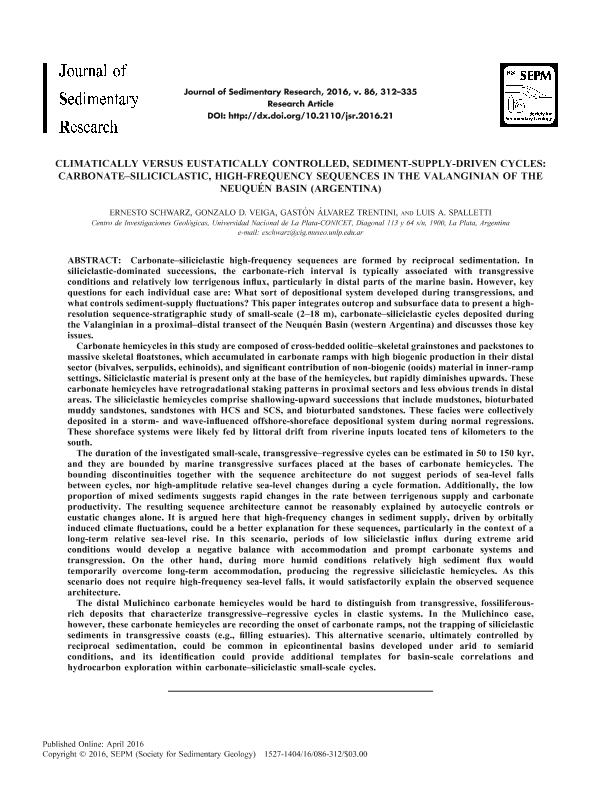Artículo
Climatically versus eustatically controlled, sediment-supply-driven cycles: Carbonate-siliciclastic, high-frequency sequences in the valanginian of the Neuqueń Basin (Argentina)
Fecha de publicación:
04/2016
Editorial:
Society for Sedimentary Geology
Revista:
Journal of Sedimentary Research - (Print)
ISSN:
1527-1404
e-ISSN:
1938-3681
Idioma:
Inglés
Tipo de recurso:
Artículo publicado
Clasificación temática:
Resumen
Carbonate–siliciclastic high-frequency sequences are formed by reciprocal sedimentation. In siliciclastic-dominated successions, the carbonate-rich interval is typically associated with transgressive conditions and relatively low terrigenous influx, particularly in distal parts of the marine basin. However, key questions for each individual case are: What sort of depositional system developed during transgressions, and what controls sediment-supply fluctuations? This paper integrates outcrop and subsurface data to present a high-resolution sequence-stratigraphic study of small-scale (2–18 m), carbonate–siliciclastic cycles deposited during the Valanginian in a proximal–distal transect of the Neuquén Basin (western Argentina) and discusses those key issues. Carbonate hemicycles in this study are composed of cross-bedded oolitic–skeletal grainstones and packstones to massive skeletal floatstones, which accumulated in carbonate ramps with high biogenic production in their distal sector (bivalves, serpulids, echinoids), and significant contribution of non-biogenic (ooids) material in inner-ramp settings. Siliciclastic material is present only at the base of the hemicycles, but rapidly diminishes upwards. These carbonate hemicycles have retrogradational staking patterns in proximal sectors and less obvious trends in distal areas. The siliciclastic hemicycles comprise shallowing-upward successions that include mudstones, bioturbated muddy sandstones, sandstones with HCS and SCS, and bioturbated sandstones. These facies were collectively deposited in a storm- and wave-influenced offshore-shoreface depositional system during normal regressions. These shoreface systems were likely fed by littoral drift from riverine inputs located tens of kilometers to the south. The duration of the investigated small-scale, transgressive–regressive cycles can be estimated in 50 to 150 kyr, and they are bounded by marine transgressive surfaces placed at the bases of carbonate hemicycles. The bounding discontinuities together with the sequence architecture do not suggest periods of sea-level falls between cycles, nor high-amplitude relative sea-level changes during a cycle formation. Additionally, the low proportion of mixed sediments suggests rapid changes in the rate between terrigenous supply and carbonate productivity. The resulting sequence architecture cannot be reasonably explained by autocyclic controls or eustatic changes alone. It is argued here that high-frequency changes in sediment supply, driven by orbitally induced climate fluctuations, could be a better explanation for these sequences, particularly in the context of a long-term relative sea-level rise. In this scenario, periods of low siliciclastic influx during extreme arid conditions would develop a negative balance with accommodation and prompt carbonate systems and transgression. On the other hand, during more humid conditions relatively high sediment flux would temporarily overcome long-term accommodation, producing the regressive siliciclastic hemicycles. As this scenario does not require high-frequency sea-level falls, it would satisfactorily explain the observed sequence architecture. The distal Mulichinco carbonate hemicycles would be hard to distinguish from transgressive, fossiliferous-rich deposits that characterize transgressive–regressive cycles in clastic systems. In the Mulichinco case, however, these carbonate hemicycles are recording the onset of carbonate ramps, not the trapping of siliciclastic sediments in transgressive coasts (e.g., filling estuaries). This alternative scenario, ultimately controlled by reciprocal sedimentation, could be common in epicontinental basins developed under arid to semiarid conditions, and its identification could provide additional templates for basin-scale correlations and hydrocarbon exploration within carbonate–siliciclastic small-scale cycles.
Archivos asociados
Licencia
Identificadores
Colecciones
Articulos(CIG)
Articulos de CENTRO DE INVEST.GEOLOGICAS (I)
Articulos de CENTRO DE INVEST.GEOLOGICAS (I)
Citación
Schwarz, Ernesto; Veiga, Gonzalo Diego; Álvarez Trentini, Gastón; Spalletti, Luis Antonio; Climatically versus eustatically controlled, sediment-supply-driven cycles: Carbonate-siliciclastic, high-frequency sequences in the valanginian of the Neuqueń Basin (Argentina); Society for Sedimentary Geology; Journal of Sedimentary Research - (Print); 86; 4; 4-2016; 312-335
Compartir
Altmétricas




